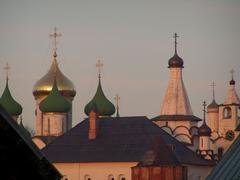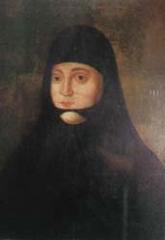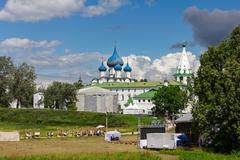
Alexandrovsky Monastery Suzdal: Visiting Hours, Tickets, and Travel Guide
Date: 04/07/2025
Introduction
Set on the scenic left bank of the Kamenka River, the Alexandrovsky Monastery in Suzdal is a vital touchstone for understanding Russia’s Orthodox spiritual traditions and medieval architecture. Founded in 1240 by Prince Alexander Nevsky during the Mongol invasions, the monastery’s survival and evolution mirror the resilience of Russian faith and culture. Through centuries of prosperity, decline, secularization under Catherine II, and Soviet-era suppression, the site has emerged as a revived male monastery since 2006—a living testament to Russia’s enduring religious heritage. Today, it stands as an essential stop for visitors exploring Suzdal and Russia’s Golden Ring, offering a uniquely tranquil and contemplative experience (Visit Russia, Advantour, en.unistica.com).
This guide details the monastery’s history, architectural highlights—including the Church of the Ascension, Holy Gates, and distinctive tented bell tower—practical visitor information such as visiting hours and ticketing, travel and accessibility tips, and guidance on combining your visit with Suzdal’s other iconic landmarks.
Table of Contents
- Introduction
- Historical Background
- Architectural Features
- Visiting Information
- Nearby Attractions
- Frequently Asked Questions (FAQ)
- Visuals and Media
- Conclusion
- References
Historical Background
Foundation and Early History
The Alexandrovsky Monastery, or St. Alexander Monastery, is among Suzdal’s oldest religious institutions. According to tradition, it was established in 1240 by Alexander Nevsky, one of Russia’s most venerated saints and military leaders. Its original wooden structures, built as a haven during the instability that followed the Mongol invasions, were gradually replaced with stone and brick (Visit Russia).
Medieval Development and Architectural Evolution
As Suzdal flourished as a religious center, the monastery developed architecturally and spiritually. By the 17th and 18th centuries, it boasted new stone walls, decorative turrets, and the iconic Holy Gates—reflecting both defensive needs and baroque sensibilities. The impressive Church of the Ascension, constructed in 1695 with support from Natalia Kirillovna, mother of Peter the Great, became the monastery’s focal point (en.atomiyme.com).
Secularization and Decline
In 1764, Catherine II’s sweeping secularization reforms led to the monastery’s abolition. Its church was converted to a parish, the monastic community was dispersed, and many buildings fell into neglect (Visit Russia).
Soviet Era and Preservation
During the Soviet period, anti-religious campaigns saw many Suzdal monasteries closed, with some repurposed as museums or left to deteriorate. The Alexandrovsky Monastery faced uncertain times, but preservation efforts in the late 20th century acknowledged Suzdal’s unique heritage, treating the city as an open-air museum (Advantour).
Revival and Modern Status
In 2006, the monastery was revived as an active male monastery under the Vladimir-Suzdal Diocese. Ongoing restorations have focused on preserving 18th-century structures and returning the site to its religious and cultural role in the region (Visit Russia).
Architectural Features
Layout and Setting
Situated on a gentle rise above the Kamenka River, the monastery’s modest but harmonious ensemble is defined by its whitewashed stone buildings, low brick fence with stylized turrets, and well-tended grounds. The spatial arrangement follows traditional Russian monastic design, with the main church and bell tower flanked by auxiliary buildings and burial plots (en.atomiyme.com).
Church of the Ascension
The Church of the Ascension, built in 1695, is an excellent example of late 17th-century Russian ecclesiastical architecture. The two-tiered quadrangular structure is topped with five domes, representing Christ and the Evangelists. Its white walls and carved wooden platbands emphasize spiritual restraint, while the interior traditionally features an iconostasis and frescoes (en.atomiyme.com).
Tented Bell Tower
The tented bell tower stands out for its octagonal pillar atop a square base, capped by a steep, tent-like roof—a style popular in Russian church architecture of the 16th and 17th centuries. It is notable for its simplicity and minimal ornamentation, reflecting the monastery’s focus on spiritual humility (commons.wikimedia.org).
Holy Gates and Defensive Structures
The Holy Gates, designed by Ivan Gryaznov, mark the principal entrance with their two-tiered tower and carved detailing. The surrounding low brick fence with decorative turrets is largely symbolic, evoking the monastery’s former defensive significance (en.atomiyme.com).
Artistic Heritage
Architectural restraint is balanced by traditional Russian Orthodox artistic elements: carved wooden platbands, arch frames, and, inside the church, an iconostasis and historic icons. While not as lavish as larger cathedrals, these features contribute to the monastery’s contemplative ambiance (en.atomiyme.com).
Visiting Information
Hours and Tickets
- Opening Hours: Daily, 9:00 AM to 6:00 PM. Hours may vary on Orthodox feast days.
- Admission: Free access to the grounds; some special exhibitions or tours may require a ticket (200–500 RUB). Tickets can be purchased on-site or via local tour operators (thenomadicvegan.com).
Accessibility
The monastery’s pathways are primarily cobblestone and uneven, with some steps and limited wheelchair access. Visitors with mobility concerns should plan accordingly. Assistance can be requested at the entrance.
Travel Tips
- Getting There: A 15-minute walk from Suzdal city center (Lenin Street), with parking available near the gates. Taxis and local buses offer alternative transport, though bus service is infrequent.
- Guided Tours: Not provided directly by the monastery, but local agencies and the tourism office offer informative tours.
- Photography: Permitted outdoors. Ask before photographing inside or during services to respect monastic privacy.
- Facilities: Restrooms are available, but there are no cafés or shops within the monastery; Suzdal’s city center offers ample amenities.
Dress Code and Etiquette
- Dress Modestly: Women should cover their heads (scarves often provided), and both men and women should wear clothing covering shoulders and knees.
- Behavior: Maintain silence and reverence, particularly during religious services.
Best Time to Visit
Late spring and early autumn offer mild weather and blooming gardens. Weekdays and early/late hours are quieter; weekends may be busier with tourists (gb.destinationsae.com).
Nearby Attractions
The monastery’s location makes it easy to combine with other Suzdal landmarks:
- Suzdal Kremlin
- Museum of Wooden Architecture
- Pokrovsky Convent
- Spaso-Yevfimiev Monastery
All are within walking distance or a short drive, offering a comprehensive tour of Suzdal’s religious and architectural heritage (travelsetu.com).
Frequently Asked Questions (FAQ)
Q: What are the visiting hours?
A: Open daily, 9:00 AM–6:00 PM. Hours may vary during holidays.
Q: Is there an admission fee?
A: Entry to the grounds is free; fees apply for some special exhibitions or tours.
Q: Are guided tours available?
A: Local agencies and the Suzdal tourism office provide guided tours for a fee.
Q: Is the site accessible for visitors with mobility issues?
A: Terrain is uneven and some buildings have limited wheelchair access.
Q: How do I get there from the Suzdal city center?
A: It’s a 15-minute walk from Lenin Street; taxis and limited buses are available.
Q: What is the dress code?
A: Modest attire is required; women should cover their heads.
Visuals and Media
- Include high-quality images of the Church of the Ascension, tented bell tower, Holy Gates, and monastery gardens, with alt text such as “Alexandrovsky Monastery Church of the Ascension in Suzdal” and “Holy Gates Entrance to Alexandrovsky Monastery.”
- Embed an interactive map showing the monastery’s location.
- Link to virtual tours if available.
Conclusion
The Alexandrovsky Monastery in Suzdal is a serene and culturally rich destination that encapsulates centuries of Russian Orthodox tradition and local resilience. Its tranquil riverside setting, harmonious architecture, and free visitor access provide a rewarding and accessible experience. Whether you are drawn by history, spirituality, or the timeless beauty of Suzdal’s landscape, the Alexandrovsky Monastery is a must-visit on your journey through Russia’s Golden Ring.
For the most current information, including special events and guided tour options, consult local tourism resources and consider using mobile apps such as Audiala for personalized travel guidance.
References
- Visit Russia: Alexandrovsky Monastery
- en.atomiyme.com: Alexandrovsky Monastery Suzdal
- thenomadicvegan.com: Suzdal Russia Things To Do
- quiltshow.ru: Suzdal
- travelsetu.com: Suzdal Tourism
- Advantour: Suzdal Overview
- Fifty Degrees North: Suzdal
- en.unistica.com: Monasteries of Suzdal
- commons.wikimedia.org: Alexandrovsky Monastery Bell Tower
- gb.destinationsae.com: What to See in Suzdal





